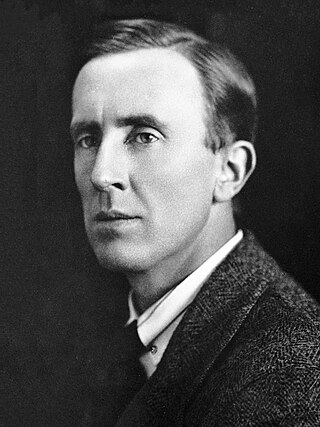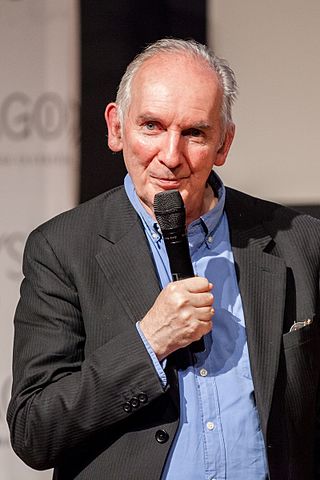
John Ronald Reuel Tolkien was an English writer and philologist. He was the author of the high fantasy works The Hobbit and The Lord of the Rings.

The Lord of the Rings is an epic high-fantasy novel by the English author and scholar J. R. R. Tolkien. Set in Middle-earth, the story began as a sequel to Tolkien's 1937 children's book The Hobbit, but eventually developed into a much larger work. Written in stages between 1937 and 1949, The Lord of the Rings is one of the best-selling books ever written, with over 150 million copies sold.

The Road Goes Ever On is a song cycle first published in 1967 as a book of sheet music and as an audio recording. The music was written by Donald Swann, and the words are taken from poems in J. R. R. Tolkien's Middle-earth writings, especially The Lord of the Rings. The title of the song cycle is taken from "The Road Goes Ever On", the first song in the collection. The songs are designed to fit together when played in sequence. The ninth song "Lúthien Tinúviel" was added in an appendix rather than in the main sequence. Swann performed the cycle for Tolkien, who approved of the music except for the Quenya song "Namárië"; he suggested it should be in the style of a Gregorian chant, which he hummed; Swann used that melody for the song.

Pauline Diana Baynes was an English illustrator, author, and commercial artist. She contributed drawings and paintings to more than 200 books, mostly in the children's genre. She was the first illustrator of some of J. R. R. Tolkien's minor works and of C. S. Lewis's Chronicles of Narnia.

Bilbo's Last Song is a poem by J. R. R. Tolkien, written as a pendant to his fantasy The Lord of the Rings. It was first published in a Dutch translation in 1973, subsequently appearing in English on posters in 1974 and as a picture-book in 1990. It was illustrated by Pauline Baynes, and set to music by Donald Swann and Stephen Oliver. The poem's copyright was owned by Tolkien's secretary, to whom he gave it in gratitude for her work for him.

Alan Lee is an English book illustrator and film conceptual designer. He is best known for his artwork inspired by J. R. R. Tolkien's fantasy novels, and for his work on the conceptual design of Peter Jackson's film adaptations of Tolkien, The Lord of the Rings and The Hobbit film series.
The following outline is provided as an overview of and topical guide to the real-world history and notable fictional elements of J. R. R. Tolkien's fantasy universe. It covers materials created by Tolkien; the works on his unpublished manuscripts, by his son Christopher Tolkien; and films, games and other media created by other people.
The works of J. R. R. Tolkien have served as the inspiration to painters, musicians, film-makers and writers, to such an extent that he is sometimes seen as the "father" of the entire genre of high fantasy.
Do not laugh! But once upon a time I had a mind to make a body of more or less connected legend, ranging from the large and cosmogonic to the level of romantic fairy-story... The cycles should be linked to a majestic whole, and yet leave scope for other minds and hands, wielding paint and music and drama. Absurd.
Anke Katrin Eißmann is a German illustrator and graphic designer known for her illustrations of J. R. R. Tolkien's legendarium. She studied visual communication at Bauhaus University in Weimar and at the Colchester Institute in the United Kingdom. Eißmann has also made a number of short films. She is an art teacher at the Johanneum high school in Herborn.

Barbara Remington was an American artist and illustrator. Born in Minnesota, she was probably best known for her cover-art for Ballantine Books' first paperback editions of J. R. R. Tolkien's novels The Hobbit and The Lord of the Rings and for her Tolkien-related poster A Map of Middle-earth.
In the fictional world of J. R. R. Tolkien, Moria, also named Khazad-dûm, is an ancient subterranean complex in Middle-earth, comprising a vast labyrinthine network of tunnels, chambers, mines and halls under the Misty Mountains, with doors on both the western and the eastern sides of the mountain range. Moria is introduced in Tolkien's novel The Hobbit, and is a major scene of action in The Lord of the Rings.

Poems and Songs of Middle Earth is a studio album of spoken-word poetry by the English author J. R. R. Tolkien and art songs composed by the English musician Donald Swann. On the first half of the album, Tolkien recites seven poems from or related to his fantasy novel The Lord of the Rings (1954–55). The second half is a performance of Swann's song cycle The Road Goes Ever On, which sets selections from Tolkien's verse to music. The vocalist William Elvin sings The Road Goes Ever On to Swann's piano accompaniment. Caedmon Records issued the album on 18 October 1967 in the United States, and then on 28 March 1968 in the United Kingdom. Its release coincided with the publication of The Road Goes Ever On as a book of sheet music with commentary and illustration by Tolkien.
"The Tale of Aragorn and Arwen" is a story within the Appendices of J. R. R. Tolkien's The Lord of the Rings. It narrates the love of the mortal Man Aragorn and the immortal Elf-maiden Arwen, telling the story of their first meeting, their eventual betrothal and marriage, and the circumstances of their deaths. Tolkien called the tale "really essential to the story". In contrast to the non-narrative appendices it extends the main story of the book to cover events both before and after it, one reason it would not fit in the main text. Tolkien gave another reason for its exclusion, namely that the main text is told from the hobbits' point of view.
The poetry in The Lord of the Rings consists of the poems and songs written by J. R. R. Tolkien, interspersed with the prose of his high fantasy novel of Middle-earth, The Lord of the Rings. The book contains over 60 pieces of verse of many kinds; some poems related to the book were published separately. Seven of Tolkien's songs, all but one from The Lord of the Rings, were made into a song-cycle, The Road Goes Ever On, set to music by Donald Swann. All the poems in The Lord of the Rings were set to music and published on CDs by The Tolkien Ensemble.

Tolkien's artwork was a key element of his creativity from the time when he began to write fiction. The philologist and author J. R. R. Tolkien prepared a wide variety of materials to support his fiction, including illustrations for his Middle-earth fantasy books, facsimile artefacts, more or less "picturesque" maps, calligraphy, and sketches and paintings from life. Some of his artworks combined several of these elements.

Scholars have identified numerous themes in J. R. R. Tolkien's Middle-earth writings, among them paganism. Despite Tolkien's assertion that The Lord of the Rings was a fundamentally Christian work, paganism appears in that book and elsewhere in his fictional world of Middle-earth in multiple ways. These include a pantheon of god-like beings, the Valar, who function like the Norse gods, the Æsir; the person of the wizard Gandalf, who Tolkien stated in a letter is an "Odinic wanderer"; Elbereth, the Elves' "Queen of the Stars", associated with Venus; animism, the way that the natural world seems to be alive; and a Beowulf-like "northern courage" which is determined to press on, no matter how bleak the outlook.
The architecture in Middle-earth, J. R. R. Tolkien's fictional world, is as varied as the Hobbit-holes of the Shire, the tree-houses of Lothlórien, the wooden halls of Rohan, and the stone dwellings and fortifications of Minas Tirith, capital of Gondor. Tolkien uses the architecture in each place, including its interior design, to provide clues to each people's character. The Hobbit Bilbo Baggins's cosy home, Bag End, described in his 1937 children's book The Hobbit, establishes the character of Hobbits as averse to travelling outside the Shire. In his fantasy novel The Lord of the Rings, Lothlórien demonstrates the close integration of the Elves with their natural environment. The King of Rohan's hall, Meduseld, indicates the Rohirrim's affinity with Anglo-Saxon culture, while Gondor's tall and beautiful stone architecture was described by Tolkien as "Byzantine". In contrast, the Dark Lord Sauron and the fallen Wizard Saruman's realms are damaged lands around tall dark towers.

Since the publication of J. R. R. Tolkien's The Hobbit in 1937, artists including Tolkien himself have sought to capture aspects of Middle-earth fantasy novels in paintings and drawings. He was followed in his lifetime by artists whose work he liked, such as Pauline Baynes, Mary Fairburn, Queen Margrethe II of Denmark, and Ted Nasmith, and by some whose work he rejected, such as Horus Engels for the German edition of The Hobbit. Tolkien had strong views on illustration of fantasy, especially in the case of his own works. His recorded opinions range from his rejection of the use of images in his 1936 essay On Fairy-Stories, to agreeing the case for decorative images for certain purposes, and his actual creation of images to accompany the text in The Hobbit and The Lord of the Rings. Commentators including Ruth Lacon and Pieter Collier have described his views on illustration as contradictory, and his requirements as being as fastidious as his editing of his novels.
Cor Blok (1956–2021) was a Dutch artist and art history teacher. He became well-known as a Tolkien illustrator.












